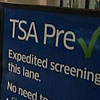
TSA Plans Mandatory Active Shooter Training for Airport Employees
 The Transportation Security Administration on March 26 released a report summarizing changes it intends to make in its policies, procedures, and operations based on the Nov. 1, 2013, killing of an employee at Los Angeles International Airport. Transportation Security Officer Gerardo I. Hernandez, 39, was shot to death, and the shooter also injured two other officers and a traveler. Hernandez is the first TSA employee to die in the line of duty since TSA was created in 2001.
The Transportation Security Administration on March 26 released a report summarizing changes it intends to make in its policies, procedures, and operations based on the Nov. 1, 2013, killing of an employee at Los Angeles International Airport. Transportation Security Officer Gerardo I. Hernandez, 39, was shot to death, and the shooter also injured two other officers and a traveler. Hernandez is the first TSA employee to die in the line of duty since TSA was created in 2001.
The suspect, Paul Anthony Ciancia, is charged with murder of a federal officer and commission of violence at an international airport. He pleaded not guilty on Dec. 26, 2013, and is awaiting trial.
"Following the incident at LAX last year, which shocked and saddened us all, I ordered a comprehensive review of policies and procedures at LAX and airports across the country. The report released today outlines the actions TSA took immediately following the shooting and new procedures to enhance the safety and security of TSA employees nationwide, especially those who work on the front lines each and every day to protect the traveling public," said TSA Administrator John S. Pistole.
TSA said the report was completed with feedback and participation from TSA employees, industry stakeholders, law enforcement, airport operators, the American Federation of Government Employees, and travel-related associations, and members of the TSA Aviation Security Advisory Committee.
"We sought the input of all TSA employees through a variety of mechanisms such as town hall meetings and the online Idea Factory. Ideas were submitted from all levels of the organization, to include our frontline officers and Federal Security Directors," Pistole said. "Many of these ideas were endorsed and incorporated into our action plan. We continue to welcome stakeholder and workforce feedback to improve safety and security at airports nationwide."
The report, "Enhancing TSA Officer Safety and Security at Airports: Agency Actions and Path Forward," outlines these changes:
- Mandatory active shooter training and exercises
- Recommending bi-annual training for airport operators
- Reinforcing emergency procedures through daily supervisor review and mandatory bi-annual evacuation drills
- Keeping employees informed of actions taken
- Providing ongoing access to grief counseling
- Improving Federal Air Marshals notification regarding active shooter incidents
- Supporting changes to first responder policies and training in responding to active shooter incidents
- Routinely testing existing alert notification capacity ("duress" alarms)
- Expanding duress coverage at screening locations across the country
- Encouraging linkage of duress alarms to CCTV systems
- Using alternate local airport emergency phone numbers
- Issuing recommended standards for law enforcement presence at checkpoints and ticket counters during peak travel times
- Ensuring explicit inclusion of maximum response times in Airport Security Programs operating under a flexible response plan
- Extending the temporary redeployment of certain VIPR teams to airports